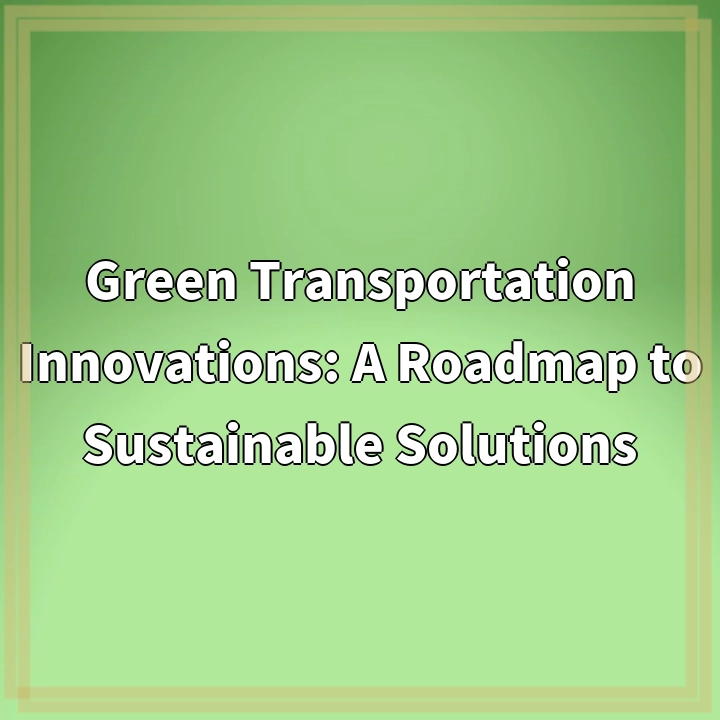
What are Green Transportation Innovations?
Green transportation innovations refer to the development and implementation of sustainable solutions in the transportation sector. It encompasses technologies, systems, and practices that aim to minimize the environmental impact of transportation, reduce greenhouse gas emissions, and promote energy efficiency.
Real-World Problems Associated with Green Transportation
While green transportation innovations offer promising solutions to environmental challenges, there are several real-world problems that need to be addressed:
1. High Cost of Implementation
Implementing green transportation innovations often requires significant investments in research, infrastructure, and technology. This financial barrier can impede widespread adoption and hinder the transition towards sustainable transportation systems.
2. Limited Infrastructure
One of the major challenges is the lack of infrastructure to support green transportation. Electric vehicle charging stations, hydrogen refueling stations, and bike lanes are still limited in many regions, making it difficult for individuals to embrace sustainable transportation options.
3. Resistance to Change
The transportation industry is deeply ingrained in conventional fossil fuel-based systems. Shifting towards green transportation requires a shift in mindset and breaking away from traditional modes of transportation. Resistance to change, both from individuals and established industries, poses a significant challenge.
4. Range and Charging Limitations
Electric vehicles have come a long way, but there are still limitations to address. Range anxiety, the fear of running out of battery without access to charging stations, is a concern for many potential electric vehicle owners. Additionally, charging times and limitations on the number of charging stations can be obstacles to widespread adoption.
5. Integration and Coordination
Green transportation innovations often involve multiple stakeholders, including governments, transportation agencies, manufacturers, and consumers. Coordinating efforts and ensuring seamless integration of new technologies and systems can be complex and time-consuming.
Conclusion
Green transportation innovations hold immense potential in addressing environmental challenges and creating more sustainable transportation systems. However, it is essential to overcome the real-world problems associated with implementation and embrace these technologies and practices to pave the way for a greener future.

Solutions for Green Transportation Innovations
The real-world problems associated with green transportation innovations can be addressed through the following solutions:
1. Increased Funding and Support
Providing sufficient funding and support from governments, organizations, and investors can help overcome the high cost of implementation. By allocating resources towards research, infrastructure development, and incentives for adopting green transportation, the financial barrier can be reduced.
2. Expansion of Infrastructure
Expanding the infrastructure for green transportation is crucial. This includes increasing the number of electric vehicle charging stations, establishing hydrogen refueling stations, creating dedicated bike lanes, and improving public transportation options. Such infrastructure will make sustainable transportation more accessible and convenient.
3. Education and Awareness
Addressing resistance to change requires education and raising awareness about the benefits of green transportation. Informing individuals about the environmental impact of conventional transportation and showcasing the advantages of sustainable alternatives can help shift mindsets and encourage adoption.
4. Advancements in Battery Technology
To alleviate range anxiety and charging limitations, advancements in battery technology are essential. Research and development in battery efficiency and the creation of fast-charging solutions can make electric vehicles more practical and appealing to a wider audience.
5. Collaboration and Coordination
Coordinated efforts among various stakeholders are necessary for successful implementation. Governments, transportation agencies, manufacturers, and consumers must work together to integrate green transportation innovations seamlessly. Collaboration can facilitate the sharing of resources, knowledge, and best practices.
Conclusion
By implementing these solutions, we can overcome the real-world problems associated with green transportation innovations. With increased funding, expanded infrastructure, education and awareness campaigns, advancements in battery technology, and collaboration among stakeholders, we can pave the way for a greener and more sustainable future in transportation.















